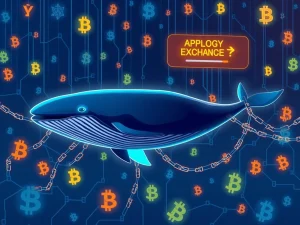Urgent: Binance Ends Tether USDT Trading in Europe Amidst MiCA Crypto Regulation

Big news shaking up the crypto space in Europe! If you’re trading or keeping an eye on the markets within the European Economic Area (EEA), you need to know about a significant shift at Binance. The leading cryptocurrency exchange has just announced the discontinuation of spot trading pairs for Tether USDT. Why the sudden change? It all boils down to compliance with the much-anticipated Markets in Crypto-Assets (MiCA) regulations. Let’s dive into what this means for you and the broader European crypto landscape.
Why is Binance Ending Tether USDT Trading in Europe?
The core reason behind Binance’s decisive action is to align with the upcoming MiCA rules. These regulations are designed to create a harmonized legal framework for crypto-assets across the European Union. While MiCA is aimed at fostering innovation and protecting consumers, it also introduces a set of compliance standards that crypto exchanges must adhere to. One key aspect of these rules pertains to stablecoins that are not fully compliant with MiCA’s requirements. Unfortunately, Tether USDT, the world’s most popular stablecoin, falls into this category for now. To proactively meet these regulatory demands, Binance has chosen to delist spot trading pairs involving USDT for its users within the EEA.
This move isn’t entirely unexpected. Binance had hinted at these potential delistings as early as March, signaling a proactive approach to regulatory compliance in the region. It’s important to note that this delisting specifically affects spot trading pairs. European users can still custody USDT and engage in perpetual contract trading with USDT on Binance. This distinction is crucial and offers a degree of continuity for users who hold USDT.
What Exactly are the MiCA Rules and How Do They Impact Crypto Regulation?
The MiCA rules represent a landmark moment for crypto regulation in Europe. They are designed to bring clarity and structure to a previously largely unregulated market. Here’s a breakdown of why MiCA is so significant:
- Harmonization: MiCA aims to create a single set of rules for crypto-assets across all EU member states. This eliminates the fragmented regulatory landscape that previously existed, making it easier for crypto businesses to operate across Europe.
- Consumer Protection: A key focus of MiCA is to protect consumers by setting standards for transparency, disclosure, and operational resilience for crypto-asset service providers (CASPs).
- Market Integrity: MiCA seeks to prevent market abuse and ensure the integrity of crypto markets, similar to regulations in traditional financial markets.
- Innovation and Growth: While ensuring regulation, MiCA also aims to foster innovation in the crypto space by providing a clear legal framework for new technologies and business models to flourish.
The impact of MiCA rules extends beyond just Binance. It’s setting a new precedent for crypto regulation globally, and other jurisdictions are likely to take note of Europe’s approach. For crypto businesses operating in or targeting the European market, understanding and complying with MiCA is no longer optional – it’s a necessity.
Are Other Exchanges in Europe Following Binance’s Lead on Tether USDT?
Yes, Binance isn’t alone in taking steps to comply with MiCA rules regarding Tether USDT and other non-compliant tokens. Kraken, another major cryptocurrency exchange, has also taken action in the EEA. Kraken announced its plans in February and by March 24th, they had restricted USDT to “sell-only” mode for EEA users. Currently, Kraken users in the EEA cannot buy USDT on the platform.
This trend indicates a broader industry shift towards MiCA compliance. It’s likely that other exchanges operating in the EEA will also need to review their offerings and potentially delist non-compliant tokens for spot trading to adhere to the new regulatory landscape. The coordinated action by major exchanges like Binance and Kraken underscores the seriousness with which the industry is taking MiCA.
Beyond USDT, Binance has also delisted spot trading pairs for a range of other tokens deemed non-MiCA compliant, including Dai (DAI), First Digital USD (FDUSD), TrueUSD (TUSD), Pax Dollar (USDP), Anchored Euro (AEUR), TerraUSD (UST), TerraClassicUSD (USTC), and PAX Gold (PAXG). Kraken’s delisting roadmap, while also significant, initially focused on a smaller set of tokens including USDT, PayPal USD (PYUSD), Tether EURt (EURT), TrueUSD, and TerraClassicUSD.
What are the Implications for European Crypto Users Holding Tether USDT?
While the delisting of Tether USDT spot trading pairs on Binance and other exchanges might seem disruptive, it’s important to understand the full scope of the changes for European crypto users:
- Continued Custody: Crucially, users in the EEA can still hold and custody Tether USDT and other affected tokens on platforms like Binance and Kraken. The regulations do not prohibit the custody of non-MiCA compliant tokens.
- Perpetual Trading Option: Even though spot trading is restricted, Binance continues to offer perpetual contract trading for USDT in the EEA. This provides an alternative avenue for users who wish to trade USDT derivatives.
- Sell-Only Mode (Kraken): In Kraken’s case, USDT is currently in “sell-only” mode, meaning users can liquidate their holdings but not buy more USDT directly on the spot market.
- Industry Adaptation: These changes are part of a broader adaptation to the evolving regulatory environment. While there might be short-term adjustments, the long-term goal is to create a more stable and regulated crypto market in Europe.
It’s worth noting that the European Securities and Markets Authority (ESMA), the EU’s financial markets regulator, has clarified that custody and transfer services for non-MiCA compliant stablecoins do not violate the new regulations. This provides a degree of reassurance and explains why exchanges are maintaining custody services despite delisting spot trading pairs.
Navigating the New Crypto Landscape in Europe
The move by Binance to end Tether USDT spot trading in Europe, driven by MiCA rules, marks a significant moment in the evolution of the crypto industry. While it may present some immediate adjustments for users, it ultimately reflects a move towards greater regulatory clarity and maturity in the European market. As crypto regulation continues to evolve globally, the proactive approach taken by exchanges like Binance and Kraken in Europe offers valuable insights into the future of compliant crypto operations.
For European crypto users, staying informed about these regulatory changes is paramount. Understanding the nuances of MiCA and how it impacts different tokens and trading activities will be crucial for navigating this new landscape effectively. While the immediate changes might feel restrictive to some, the long-term vision is to build a more robust, secure, and sustainable crypto ecosystem within Europe.
Key Takeaways:
- Binance has delisted spot trading pairs for Tether USDT and other non-MiCA compliant tokens in the EEA to comply with MiCA rules.
- European users can still custody USDT and trade it in perpetual contracts on Binance.
- Kraken has also restricted USDT to sell-only mode in the EEA for MiCA compliance.
- MiCA rules aim to harmonize crypto regulation across Europe, enhance consumer protection, and ensure market integrity.
- The delistings are part of a broader industry adaptation to the evolving regulatory landscape in Europe.









